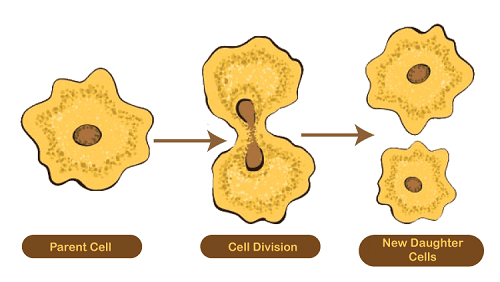Asexual Reproduction DefinitionAsexual reproduction is a biological process that allows organisms to procreate without the use of sex cells or gametes like sperm and eggs. Instead, the new organism is reproduced by a single parent and receives all of its genetic makeup from that parent. Many various kinds of species, including plants, fungi, and animals, are capable of having asexual reproduction. 
Types of Asexual ReproductionAsexual reproduction is common in plants, fungi, and some other organism, and it can take several different forms. Some of the different types of asexual reproduction are listed below: 1. Binary FissionIt is typical for bacteria and some protozoa to reproduce asexually by binary fission. When a cell divides into two genetically identical daughter cells, it is said to undergo binary fission. DNA replication and splitting into two separate copies at opposing ends of the cell are both involved in this process. A copy of the DNA is present in each of the two daughter cells when the cell divides into two. For single-celled organisms to reproduce, binary fission is a quick and easy process. 2. BuddingMany plants engage in the process of budding, a sort of asexual reproduction. A little outgrowth or bulge on the parent organism arises during budding, and this outgrowth or bulge eventually matures into an offspring that is genetically similar to the parent. A colony of genetically identical individuals may form in specific circumstances when the offspring stays bound to the parent. Yeast, the hydra, and several coral species are examples of creatures that exhibit budding. 3. Vegetative ReproductionA sort of asexual reproduction that is frequent in plants is called vegetative reproduction. A new plant is created during vegetative reproduction from a vegetative portion of the parent plant, like a stem or a leaf. This can happen organically, when a stem sprouts roots and becomes a new plant, or it can be caused intentionally, like when a gardener takes a cutting from a plant and stimulates it to grow roots. Farmers and gardeners may swiftly and effectively grow new plants by using vegetative reproduction, which is an important method for plants to spread themselves. 4. FragmentationSeveral multicellular animals, including sponges, flatworms, and sea stars, reproduce asexually through a process known as fragmentation. The parent organism fragments into numerous parts, each of which has the ability to redevelop into a new organism. For creatures that can regrow destroyed body parts, fragmentation is a desirable technique since it enables them to quickly restore an entire organism from a single piece. 5. ParthenogenesisIn some species, an unfertilized egg grows into an offspring through a process known as parthenogenesis. A few species of fish, lizards, and insects also engage in this process. It is possible to experimentally produce parthenogenesis in a laboratory setting or for it to happen naturally, as it occurs in some reptiles. When parthenogenesis occurs, it can sometimes produce kids that are genetically similar to the parents, and, in other instances, it can produce offspring that combine the genes of the parents. 6. ApomixisSimilar to parthenogenesis, apomixis is a type of asexual reproduction that happens in plants. A seed is formed during apomixis without the aid of sperm fertilizing an egg. This can happen naturally, as it does in some types of grass and dandelion, or it can be purposefully created in a laboratory. Apomixis is a vital method used by plants to generate offspring that are genetically identical to the parent, enabling them to keep beneficial features. 7. RegenerationSeveral creatures, including flatworms, lizards, and starfish, engage in regeneration, a kind of asexual reproduction. The organism can regenerate missing body parts like limbs or tails during this process. Asexual reproduction is possible in specific situations where the missing bodily part can grow into a new person. Regeneration can be purposefully created in a laboratory setting or it can happen naturally, as it does in some salamander species. For animals to heal wounds and replace lost body parts, regeneration is a crucial approach. 8. Self-FertilizationCertain hermaphroditic animals and plants will self-fertilize, which is a sort of asexual reproduction. The creature can fertilize its own eggs with its own sperm during self-fertilization, producing progeny that is genetically identical to the fertilized eggs. Self-fertilization can occur naturally, as it does in some species of snails and worms, or it can be purposefully created in a laboratory. In situations where partners are uncommon or difficult to obtain, self-fertilization is a helpful technique for organisms. 9. CloningCloning is a method of asexual reproduction in which a genetically identical duplicate of an organism is produced. Cloning can happen naturally, as it does in some plants that generate runners, which are long stems that grow along the ground and periodically give rise to new plants. Cloning can also be induced artificially, as was done with Dolly the sheep, the first mammal to be cloned from an adult cell. Cloning has numerous potential uses in agriculture, health, and conservation, but it is also debatable because of ethical issues. Advantages and Disadvantages of ReproductionThis type of reproduction is commonly observed in organisms like bacteria, fungi, and plants. While asexual reproduction offers several advantages, it also comes with its fair share of disadvantages. Advantages of Asexual Reproduction:
Disadvantages of Asexual Reproduction
How is Asexual Reproduction different from Sexual Reproduction?The two essentially distinct ways by which organisms can make offspring are asexual reproduction and sexual reproduction. Sexual reproduction involves the union of gametes from two different parent organisms to produce offspring that are genetically diverse, as opposed to asexual reproduction, which results in genetically identical offspring from a single-parent organism. These two systems differ significantly in a number of important ways, which are listed below.
Next TopicConstant Definition
|
 For Videos Join Our Youtube Channel: Join Now
For Videos Join Our Youtube Channel: Join Now
Feedback
- Send your Feedback to [email protected]
Help Others, Please Share









